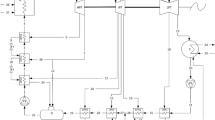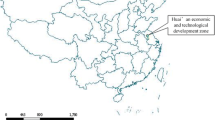Abstract
In this article, a new procedure was introduced for the optimal design of utility system in process industries. This method was based on the development of the R-curve concept and a new cogeneration targeting through estimating costs, environmental impacts, exergoeconomic, and exergoenvironmental analyses. In the exergoenvironmental analysis, the environmental impacts obtained by life cycle assessment are apportioned to the exergy streams pointing out the main system components with the highest environmental impact and possible improvements associated with these components. Moreover, exergoenvironmental variables are calculated, and an exergoenvironmental evaluation is carried out. In this regard, correlations for estimating the environmental impacts of cogeneration system have been introduced. In addition, the powerful and accurate cogeneration targeting method was applied. Also, the new graphic representations have been proposed. These curves are based on cost estimation, environmental impacts, and exergoenvironmental analysis. In addition, the optimal design of site utility was carried out in Iran LNG cogeneration plant, in which the usefulness of this method was clearly demonstrated.












Similar content being viewed by others
Abbreviations
- \( \varphi_{k} \) :
-
Maintenance factor
- \( \eta_{\text{cogen}} \) :
-
Cogeneration efficiency (%)
- b :
-
Specific environmental impact per unit of exergy (Pts/GJ)
- \( \dot{B} \) :
-
Environmental impact rate associated with exergy (mPts/s)
- c :
-
Cost per unit of exergy ($/GJ)
- \( \dot{C} \) :
-
Cost associated with an exergy stream ($/s)
- \( c_{{{\text{p}} . {\text{import}}}} \) :
-
Price of importing power ($/kWh)
- \( c_{\text{f}} \) :
-
Price of fuel ($/kWh)
- \( c_{\text{p}} \) :
-
Specific heat of saturated water (MWh/tC)
- \( \dot{C}_{\text{D}} \) :
-
Cost rates of exergy destruction ($/h)
- \( \dot{C}_{F} \) :
-
Fuel cost ($/h)
- \( C_{{{\text{F,}}k}} \) :
-
Cost rates of fuel in the kth component ($/MW)
- \( C_{\text{GT}} \) :
-
Capital investment for gas turbine system (106 $)
- \( C_{i} \) :
-
Initial investment cost (106 $)
- C P :
-
Product cost ($/h)
- \({C_{P,k}}\) :
-
Cost rates of product in the kth component ($/MW)
- \( C_{\text{ST}} \) :
-
Capital investment for steam turbine system (106 $)
- \( {\text{CRF}}_{{\left( {i,n} \right)}} \) :
-
Capital recovery factor
- \( \dot{E}_{\text{D}} \) :
-
Exergy destruction (MW)
- H:
-
Specific enthalpy (kJ/kg)
- \( \overline{\Delta H}_{\text{is}} \) :
-
Isentropic enthalpy change between the steam turbine inlet and outlet (MWh/t)
- \( m_{{{\text{exhaust}}\text{.}{\text{GT}}}} \) :
-
Flow rate of gas turbine exhaust (kg/s)
- \( m_{\hbox{max} } \) :
-
Maximum steam flow rate of steam turbine (t/h)
- \( \dot{m}_{i}^{\text{DEM}} \) :
-
Mass flow of process steam demand (t/h)
- \( \dot{m}_{i}^{\text{GEM}} \) :
-
Mass flow of process steam generation (t/h)
- N :
-
Slope of the Willan’s line for steam turbine (MWh/t)
- P:
-
Pressure (Bar)
- \( {\text{PW}} \) :
-
Present worth (106 $)
- \( {\text{PWF}}_{{\left( {i,n} \right)}} \) :
-
Present worth factor
- S :
-
Specific entropy (kJ/kgK)
- \( S_{n} \) :
-
Salvage value (106 $)
- \( T_{{{\text{exhaust}} . {\text{GT}}}} \) :
-
Exhaust temperature of gas turbine (°C)
- \( T_{\text{s,ave}} \) :
-
Average saturation temperature between the turbine inlet and outlet (°C)
- \( T_{\text{s,in}} \) :
-
Saturation temperature of steam turbine inlet (°C)
- \( T_{\text{s,out}} \) :
-
Saturation temperature of steam turbine outlet (°C)
- \( \Delta T_{\text{s}} \) :
-
Saturation temperature difference between the inlet and outlet (°C)
- TAC:
-
Total annualized cost (106 $)
- \( \dot{q}_{\text{in}} \) :
-
Heat content in the inlet (MWh/t)
- \( \dot{q}_{\text{out}} \) :
-
Heat content in the outlet (MWh/t)
- \( \dot{Q}_{\text{fuel}} \) :
-
Fuel consumption (MW)
- \( \dot{Q}_{{{\text{fuel}} . {\text{GT}}}} \) :
-
Fuel consumption of gas turbine (MW)
- \( \dot{Q}_{\text{heat}} \) :
-
Heat demand of steam (MW)
- \( \dot{Q}_{{{\text{heat}} . {\text{HRSG}}}} \) :
-
Heat content in the steam generated from HRSG (MW)
- \( \dot{W} \) :
-
Power demand (MW)
- \( \dot{W}_{{{\text{GT}}.\hbox{max} }} \) :
-
Maximum power generation of gas turbine (MW)
- \( \dot{W}_{\text{import}} \) :
-
Importing power (MW)
- \( \dot{W}_{\text{loss}} \) :
-
Internal loss of steam turbine (MW)
- \( \dot{Z}_{k} \) :
-
Cost rates of total \( \dot{Z}^{\text{CI}} \) and \( \dot{Z}^{\text{OM}} \) ($/h)
- \( \dot{Z}_{k} \) :
-
Capital cost rate of unit k ($/h)
- \( \dot{Z}^{\text{CI}} \) :
-
Cost rates associated with capital investment ($/h)
- \( \dot{Z}^{\text{OM}} \) :
-
Cost rates associated with operating and maintenance ($/h)
References
Al-Azri NA (2008) Integrated approaches to the optimization of process-utility systems. Ph.D. Thesis, Texas A&M University, USA
Al-Azri N, Al-Thubaiti M, El-Halwagi M (2009) An algorithmic approach to the optimization of process cogeneration. Clean Technol Environ Policy 11:329–338
Bamufleh HS, Ponce-Ortega JM, El-Halwagi MM (2013) Multi-objective optimization of process cogeneration systems with economic, environmental, and social tradeoffs. Clean Technol Environ Policy 15:185–197
Bandyopadhyay S, Varghese J, Bansal V (2010) Targeting for cogeneration potential through total site integration. Appl Therm Eng 30:6–14
Bejan A, Tsatsaronis G, Moran M (1996) Thermal design and optimization. Wiley, New York
Boyano A, Blanco-Marigorta AM, Morosuk T, Tsatsaronis G (2010) Exergoenvironmental analysis of a steam methane reforming process for hydrogen production. Energy Int J. doi:10.1016/j.energy.2010.05.020
Boyano A, Morosuk T, Blanco-Marigorta AM, Tsatsaronis G (2012) Conventional and advanced exergoenvironmental analysis of a steam methane reforming reactor for hydrogen production. J Clean Prod 20:152–160
Chao Z, Yan W (2006) Exergy cost analysis of a coal fired power plant based on structural theory of thermoeconomics. Energy Convers Manag 47:817–843
Compilation of air pollutant emission factors (1998) In: Stationary point and area sources, 5th edn, vol 1. US Environmental Protection Agency, Office of Air Quality Planning and Standards; AP-42, Research Triangle Park
Dhole VR, Linnhoff B (1993) Total site targets for fuel, cogeneration, emissions and cooling. Comput Chem Eng 17:S101–S109
Ghannadzadeh A, Perry S, Smith R (2011) Cogeneration targeting for site utility systems. Appl Therm Eng 43:7–13
Gutiérrez-Arriaga CG, Serna-González M, Ponce-Ortega JM, El-Halwagi MM (2013) Multi-objective optimization of steam power plants for sustainable generation of electricity. Clean Technol Environ Policy 15:551–566
Harell DA (2004) Resource conservation and allocation via process integration. Ph.D. Thesis, Texas A&M University, USA
International Organization for Standardization (ISO) (2006) Environ-mental management—life cycle assessment. European Standard ENISO 14040 and 14044, Geneva, Switzerland
Kapil A, Bulatov I, Smith R, Kim JK (2012) Site-wide low-grade heat recovery with a new cogeneration targeting method. Chem Eng Res Des 90:677–689
Karimkashi S, Amidpour M (2012) Total site energy improvement using R-curve concept. Energy 40:329–340
Kenney WF (1984) Energy conservation in process industries. Academic Press, Orlando, London
Kimura H, Zhu XX (2000) R-curve concept and its application for industrial energy management. Ind Eng Chem Res 39:2315–2335
Klemes J, Dhole VR, Raissi K, Perry SJ, Puigjaner L (1997) Targeting and design methodology for reduction of fuel power and CO2 on total sites. Appl Therm Eng 17(8–10):993–1003
Lazzaretto A, Tsatsaronis G (2006) SPECO: a systematic and general methodology for calculating efficiencies and costs in thermal systems. Energy 31:1257–1289
Manesh MHK, Amidpour M, Abadi HKJ (2009a) Comparison of combined cycle and conventional steam power plant through energy level and thermoeconomic analysis. ASME, Houston
Manesh MHK, Mazhari V, Amidpour M (2009b) Power plant optimization study in Iran LNG Project through MINLP Method. In: Klemeš J, AIDIC Servizi S.r.l. (ed) Chemical engineering transactions, vol 18. ISBN 978-88-95608-04-4; ISSN 1974-9791
Manesh MHK, Navid P, Amidpour M, Marigorta AB (2012a) Optimal design of combined heat and power system using R-curve concept. In: Proceedings of the ASME International Mechanical Engineering Congress and Exposition, Houston, USA, 9–6 November 2012
Manesh MHK, Abadi SK, Amidpour M, Hamedi MH (2012b) A new targeting method for estimation of cogeneration potential and total annualized cost in process industries. J Chem Eng Res Des. doi:10.1016/j.cherd.2012.12.002
Manesh MHK, Ghalami H, Amidpour M, Hamedi MH (2012c) A new targeting method for combined heat, power and desalinated water production in total site. J Desalination 307:51–61. doi:10.1016/j.desal.2012.08.030
Manesh MHK, Abadi SK, Amidpour M, Ghalami H, Hamedi MH (2012d) New emissions targeting strategy for site utility of process industries. J Korean J Chem Eng. doi:10.1007/s11814-012-0218-6
Manesh MHK, Navid P, Amidpour M, Hamedi MH (2013a) New procedure for optimal design of cogeneration system with considering environmental impacts and total cost. J Clean Technol Environ Policy. doi:10.1007/s10098-012-0576-0
Manesh MHK, Amidpour M, Abadi SK, Hamedi MH (2013b) A new cogeneration targeting procedure for total site utility system. J Appl Therm Eng. doi:10.1016/j.applthermaleng.2013.01.043
Mavromatis SP, Kokossis AC (1998) Conceptual optimization of utility networks for operational variations—I. targets and level optimization. Chem Eng Sci 53(8):1585–1608
Medina-Flores JM, Pico′n-Nu′n˜ez M (2010) Modelling the power production of single and multiple extraction steam turbines. Chem Eng Sci 65:2811–2820
Meyer L, Tsatsaronis G, Buchgeister J, Schebek L (2009) Exergo-environmental analysis for evaluation of the environmental impact of energy conversion systems. Energy Int J 34:75–89
Mohan T, El-Halwagi MM (2007) An algebraic targeting approach for effective utilization of biomass in combined heat and power systems through process integration. Clean Technol Environ Policy 9:13–25
Morosuk T, Tsatsaronis G, Boyano A, Gantiva C (2012) Advanced exergy-based analyses applied to a system including LNG regasification and electricity generation. Int J Energy Environ Eng 3:1
Petrakopoulou F (2010) Comparative evaluation of power plants with CO2 capture: thermodynamic, economic and environmental performance. Ph.D. Thesis, Technische Universität Berlin, Germany
Raissi K (1994) Total site integration. Ph.D. Thesis, UMIST, Manchester, England
Salisbury JK (1942) The steam turbine regenerative cycle—an analytical approach. ASME Trans 64:231–245
Sima Pro (2007) User’s manual. Pre Consultants BV, Amersfoort
Sorin M, Hammache A (2005) A new thermodynamic model for shaft work targeting on total sites. Appl Therm Eng 25:961–972
Tibi NA, Arman H (2007) A linear programming model to optimize the decision-making to managing cogeneration system. Clean Technol Environ Policy 9:235–240
Tokos H, Pintarič ZN, Krajnc D (2012) An integrated sustainability performance assessment and benchmarking of breweries. Clean Technol Environ Policy 14:173–193
Tora EA, El-Halwagi MM (2009) Optimal design and integration of solar systems and fossil fuels for sustainable and stable power outlet. Clean Technol Environ Policy 11:401–407
Tsatsaronis G, Cziesla F (2002) Encyclopedia of physical science and technology. Academic Press 16:659–680
Tsatsaronis G, Morosuk T (2008a) A general exergy-based method for combining a cost analysis with an environmental impact analysis. Part I—theoretical development. In: Proceedings of the ASME international mechanical engineering congress and exposition (IMECE2008-67218), Boston, 31 October–6 November 2008
Tsatsaronis G, Morosuk T (2008b) A general exergy-based method for combining a cost analysis with an environmental impact analysis. Part II—application to a cogeneration system. In: Proceedings of the ASME international mechanical engineering congress and exposition (IMECE2008-67219), Boston, 31 October–6 November 2008
Tsatsaronis G, Morosuk T, Cziesla F (2009) LNG-based cogeneration systems. Part 2. Advanced exergy-based analyses of a concept. Paper presented at the ASME 2009 international mechanical engineering congress and exposition (IMECE2009-10460), Lake Buena Vista, Florida, 13–19 November 2009
Ubando TA, Culaba AB, Aviso KB, Tan RR (2013) Simultaneous carbon footprint allocation and design of trigeneration plants using fuzzy fractional programming. Clean Technol Environ Policy 15:823–832
Varbanov PS, Doyle S, Smith R (2004) Modeling and optimization of utility systems. Chem Eng Res Des A 82(5):561–5778
Acknowledgments
The authors thank the Iran Power Plant Project Management Company (MAPNA Group) for data and financial supports. This study was also supported by K. N. Toosi University of Technology.
Author information
Authors and Affiliations
Corresponding author
Rights and permissions
About this article
Cite this article
Navid, P., Manesh, M.H.K. & Marigorta, A.M.B. Optimal design of cogeneration system based on exergoenvironmental analysis. Clean Techn Environ Policy 16, 1045–1065 (2014). https://doi.org/10.1007/s10098-013-0705-4
Received:
Accepted:
Published:
Issue Date:
DOI: https://doi.org/10.1007/s10098-013-0705-4




